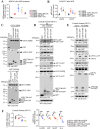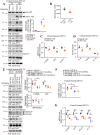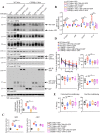A delta-secretase-truncated APP fragment activates CEBPB, mediating Alzheimer's disease pathologies
- PMID: 33880508
- PMCID: PMC8320270
- DOI: 10.1093/brain/awab062
A delta-secretase-truncated APP fragment activates CEBPB, mediating Alzheimer's disease pathologies
Abstract
Amyloid-β precursor protein (APP) is sequentially cleaved by secretases and generates amyloid-β, the major components in senile plaques in Alzheimer's disease. APP is upregulated in human Alzheimer's disease brains. However, the molecular mechanism of how APP contributes to Alzheimer's disease pathogenesis remains incompletely understood. Here we show that truncated APP C586-695 fragment generated by δ-secretase directly binds to CCAAT/enhancer-binding protein beta (CEBPB), an inflammatory transcription factor, and enhances its transcriptional activity, escalating Alzheimer's disease-related gene expression and pathogenesis. The APP C586-695 fragment, but not full-length APP, strongly associates with CEBPB and elicits its nuclear translocation and augments the transcriptional activities on APP itself, MAPT (microtubule-associated protein tau), δ-secretase and inflammatory cytokine mRNA expression, finally triggering Alzheimer's disease pathology and cognitive disorder in a viral overexpression mouse model. Blockade of δ-secretase cleavage of APP by mutating the cleavage sites reduces its stimulatory effect on CEBPB, alleviating amyloid pathology and cognitive dysfunctions. Clearance of APP C586-695 from 5xFAD mice by antibody administration mitigates Alzheimer's disease pathologies and restores cognitive functions. Thus, in addition to the sequestration of amyloid-β, APP implicates in Alzheimer's disease pathology by activating CEBPB upon δ-secretase cleavage.
Keywords: AICD; APP; C/EBPβ; transcription factor; δ-secretase.
© The Author(s) (2021). Published by Oxford University Press on behalf of the Guarantors of Brain. All rights reserved. For permissions, please email: journals.permissions@oup.com.
Figures







Similar articles
-
Spatiotemporal activation of the C/EBPβ/δ-secretase axis regulates the pathogenesis of Alzheimer's disease.Proc Natl Acad Sci U S A. 2018 Dec 26;115(52):E12427-E12434. doi: 10.1073/pnas.1815915115. Epub 2018 Dec 10. Proc Natl Acad Sci U S A. 2018. PMID: 30530690 Free PMC article.
-
C/EBPβ regulates delta-secretase expression and mediates pathogenesis in mouse models of Alzheimer's disease.Nat Commun. 2018 May 3;9(1):1784. doi: 10.1038/s41467-018-04120-z. Nat Commun. 2018. PMID: 29725016 Free PMC article.
-
Delta- and beta- secretases crosstalk amplifies the amyloidogenic pathway in Alzheimer's disease.Prog Neurobiol. 2021 Sep;204:102113. doi: 10.1016/j.pneurobio.2021.102113. Epub 2021 Jun 21. Prog Neurobiol. 2021. PMID: 34166772 Free PMC article.
-
APP processing in Alzheimer's disease.Mol Brain. 2011 Jan 7;4:3. doi: 10.1186/1756-6606-4-3. Mol Brain. 2011. PMID: 21214928 Free PMC article. Review.
-
A mechanism for beta-amyloid overproduction in Alzheimer's disease: precursor-independent generation of beta-amyloid via antisense RNA-primed mRNA synthesis.FEBS Lett. 1996 Jul 22;390(2):124-8. doi: 10.1016/0014-5793(96)00663-1. FEBS Lett. 1996. PMID: 8706841 Review.
Cited by
-
AEP-cleaved DDX3X induces alternative RNA splicing events to mediate cancer cell adaptation in harsh microenvironments.J Clin Invest. 2023 Nov 21;134(3):e173299. doi: 10.1172/JCI173299. J Clin Invest. 2023. PMID: 37988165 Free PMC article.
-
C/EBPβ: A transcription factor associated with the irreversible progression of Alzheimer's disease.CNS Neurosci Ther. 2024 Apr;30(4):e14721. doi: 10.1111/cns.14721. CNS Neurosci Ther. 2024. PMID: 38644578 Free PMC article.
-
Discovery of plasma biomarkers related to blood-brain barrier dysregulation in Alzheimer's disease.Front Bioinform. 2024 Oct 4;4:1463001. doi: 10.3389/fbinf.2024.1463001. eCollection 2024. Front Bioinform. 2024. PMID: 39429696 Free PMC article.
-
Non-canonical function of DPP4 promotes cognitive impairment through ERp29-associated mitochondrial calcium overload in diabetes.iScience. 2023 Feb 27;26(3):106271. doi: 10.1016/j.isci.2023.106271. eCollection 2023 Mar 17. iScience. 2023. PMID: 36936785 Free PMC article.
-
Amyloid Cascade Hypothesis for the Treatment of Alzheimer's Disease: Progress and Challenges.Aging Dis. 2022 Dec 1;13(6):1745-1758. doi: 10.14336/AD.2022.0412. eCollection 2022 Dec 1. Aging Dis. 2022. PMID: 36465173 Free PMC article.
References
-
- Selkoe DJ. Alzheimer's disease: A central role for amyloid. J Neuropathol Exp Neurol. 1994;53:438–447. - PubMed
-
- Estus S, Golde TE, Younkin SG.. Normal processing of the Alzheimer's disease amyloid beta protein precursor generates potentially amyloidogenic carboxyl-terminal derivatives. Ann NY Acad Sci. 1992;674:138–148. - PubMed
-
- McLoughlin DM, Miller CC.. The FE65 proteins and Alzheimer's disease. J Neurosci Res. 2008;86:744–754. - PubMed
-
- Cao X, Sudhof TC.. A transcriptionally [correction of transcriptively] active complex of APP with Fe65 and histone acetyltransferase Tip60. Science. 2001;293:115–120. - PubMed
Publication types
MeSH terms
Substances
Grants and funding
LinkOut - more resources
Full Text Sources
Other Literature Sources
Medical

